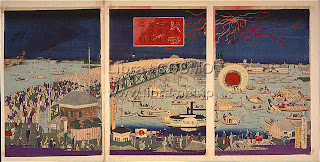Bake-danuki
Bake-danuki (化け狸) are a kind of tanuki yōkai (ghost) found in the classics and in the folklore and legends of various places in Japan.
Although the tanuki is an real, extant animal, the bake-danuki that appears in literature has always been depicted as a strange, even supernatural animal. The earliest appearance of the bake-danuki in literature, in the Nihon Shoki written by the Empress Suiko during the Nara period, consists of such passages as "in two months of spring, there are mujina in the country of Mutsu , they turn into humans and sing songs. Bake-danuki subsequently appear in such classics as the Nihon Ryōikiand the Uji Shūi Monogatari. In some regions of Japan, bake-danuki are reputed to have abilities similar to those attributed to kitsune (foxes): they can shapeshift into other things,shapeshift people, and possess human beings.
There are many legends of tanukis in the Sado Islands of Niigata Prefecture and in Shikoku, and among them, like the danzaburou-danuki of Sado, the awa-tanuki-gassen of Awa Province (Tokushima Prefecture), and the yasima-no-hage-danuki of Kagawa Prefecture, the tanuki who possessed special abilities were given names, and even became the subject of rituals. Apart from these places, there are few cases where tanuki are treated with special regard.
The character 狸, pronounced lí in modern Mandarin, was originally a collective name for medium-sized mammals resembling cats in China, with the leopard cat as its nucleus. When this character was brought to Japan, there were no animals to which it could be suitably applied. Japanese intellectuals used the character to signify tanuki, stray cats, wild boars, Eurasian badgers, weasels, and Japanese giant flying squirrels.
The tanuki of Japan from time immemorial were deified as governing all things in nature, but after the arrival of Buddhism, animals other than envoys of the gods (foxes, snakes, etc.) lost their divinity. Since all that remained was the image of possessing special powers, they were seen as evil or as yōkai, with tanuki being a representative type. Some also take the viewpoint that the image of the tanuki has overlapped with that of the mysterious and fearful 狸 of China (leopard cat).However, since the tanuki of Japan do not have the fearsome image that the leopard-cats of China do, unlike in China their image took the form of a more humorous kind of monster,[8] and even in folktales like Kachi-kachi Yama, and Bunbuku Chagama, they often played the part of foolish animals.
Compared with kitsune (foxes), which are the epitome of shape-changing animals, there is the saying that "the fox has seven disguises, the tanuki has eight (狐七化け、狸八化け)". The tanuki is thus superior to the fox in its disguises, but unlike the fox, which changes its form for the sake of tempting people, tanuki do so to fool people and make them seem stupid. There is also the theory that they simply like to change their form.























































